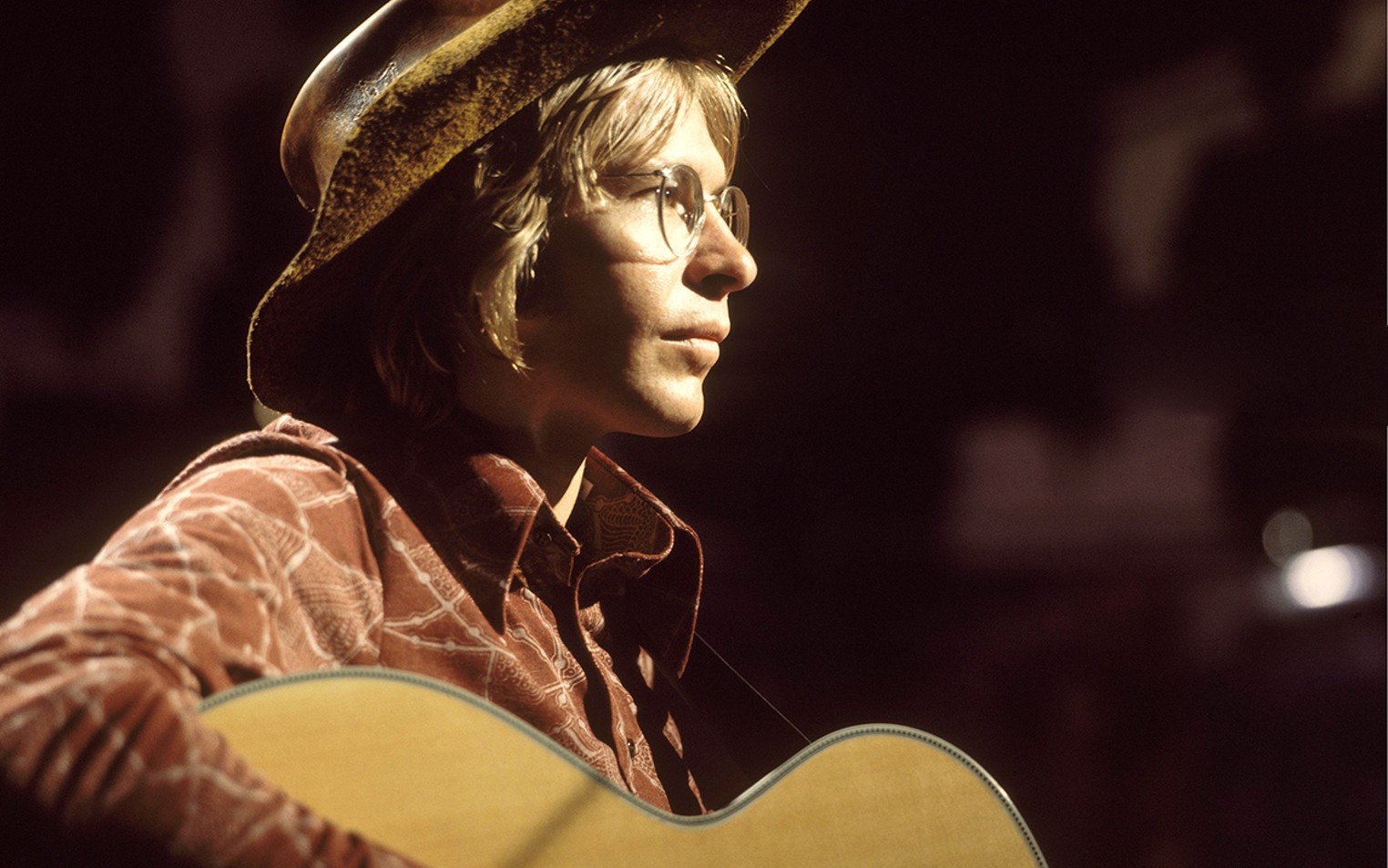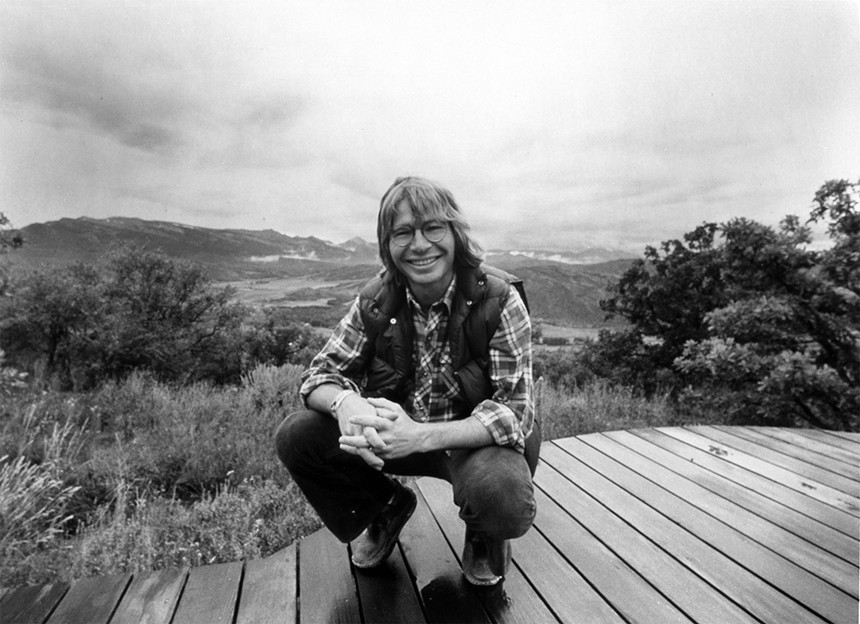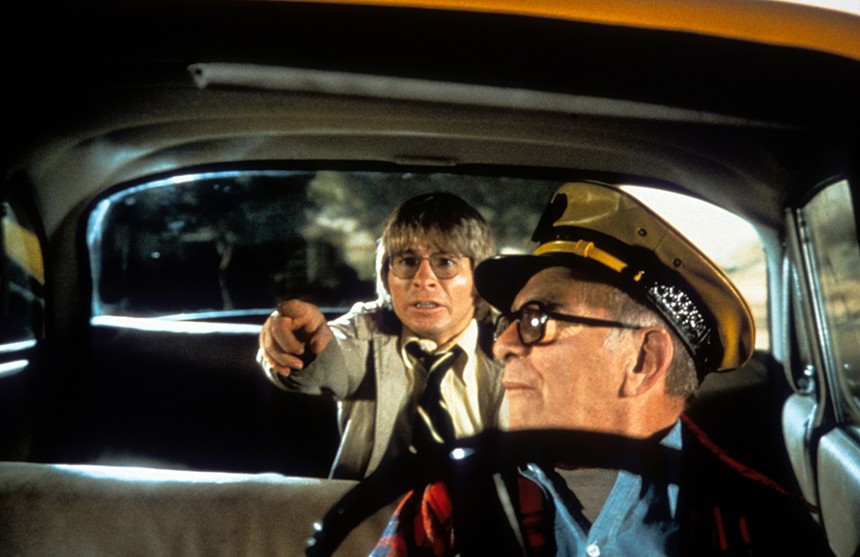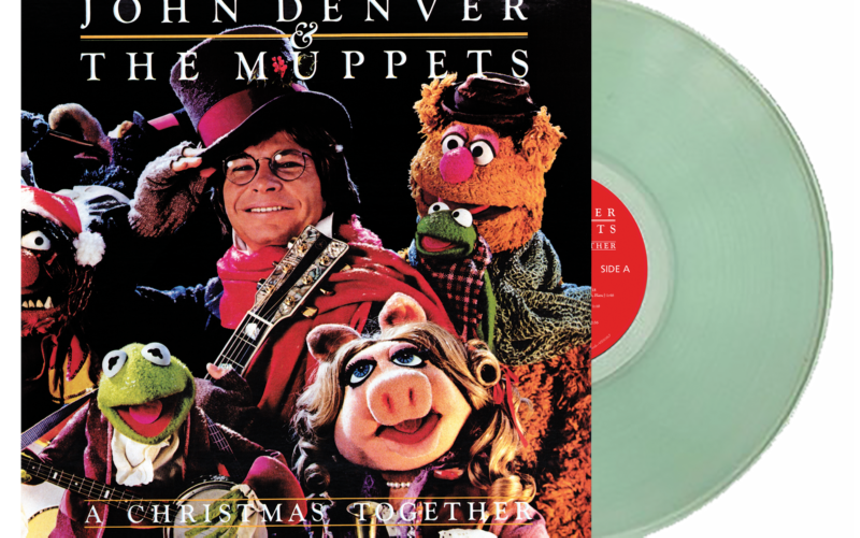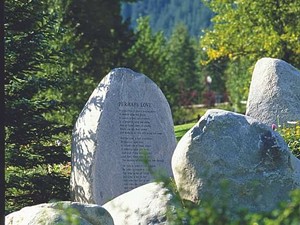The song became so pervasive that the Colorado Legislature finally voted to make it the second official state song in 2007. (Good thing, too, since you’d be hard-pressed to find anyone who can even hum any of the first official state song, a 1911 piece of schmaltz called “Where the Columbines Grow.”) Lawmakers passed the resolution even though there was some snickering about the word “high” being a drug reference, as suggested by one of the last lines, “Friends around the campfire and everybody’s high…Rocky Mountain high (high in Colorado).” Republicans consoled themselves with the explanation that the word reflected the state’s quality of life, not a state of intoxication.
Throughout the fall and into 1973, “Rocky Mountain High” was ubiquitous on Colorado and national airwaves, though it wasn’t as big a hit as the previous year’s “Take Me Home, Country Roads,” which climbed to number two on the pop charts and in 2014 was made the official state song of West Virginia. (See the biggest songs in 1972 below.)
In his autobiography, Take Me Home, Denver wrote that when he was camping and caught the annual Perseid meteor shower, he was almost done recording his next album, which was going to be called Mother Nature’s Son, after the Beatles song he covered on the record. But the meteor shower inspired him, and as “Rocky Mountain High” came together over the next couple of weeks, Denver’s guitar-playing friend Mike Taylor came up with the acoustic guitar-picking that opens the track.
Denver made it the album’s title song and created a soundtrack for a state.
As he says in the song’s first line, John Denver was “born in the summer of [his] 27th year” — but Henry John Deutschendorf Jr. was born in 1943 in Roswell, New Mexico (the focus of so many captured alien myths…or are they?). He was the son of an Army Air Force pilot based there at the time, and from there had a nomadic upbringing as a military brat.
He learned to play guitar on an instrument handed down to him by his grandmother in Oklahoma, and was studying architecture in Texas when he decided he’d rather be a musician. The folk scene was exploding, sparked by Woody Guthrie, Harry Belafonte, Pete Seeger and the Weavers, and others. Like his generational peers — members of Peter, Paul and Mary, Simon and Garfunkel, and the New Christy Minstrels — Deutschendorf wrote songs and played them on the guitar, singing along in his clear, emotive voice.
He headed west to Los Angeles, where he was told that his name wasn’t star material. He swapped Deutschendorf for Denver, the capital of his favorite state to visit, at age twenty. He was chosen to replace Chad Mitchell in an established folk group, the Chad Mitchell Trio, in 1965.
While touring with the group, Denver was introduced to activism by another act on the same college and folk-club circuit, comedian Dick Gregory, who was becoming vocally anti-war and criticizing U.S. involvement in Vietnam. Denver joined the protests and participated in an anti-war demonstration in Washington, D.C. In his autobiography, he credits being in the trio as the catalyst for his political conscience.
In 1969, the Chad Mitchell Trio changed its name to Denver, Boise and Johnson because no original member was left. But the group dissolved not long after, and Denver went out on his own as a solo singer-songwriter.
That summer, the summer of Woodstock, Denver’s manager got him a solo recording contract with RCA Records, and he promptly released his first two albums, which didn’t exactly light the charts on fire. But that’s when Denver’s songwriting — rather than his performances — brought his first taste of real fame.
In 1966, Denver had written a song that he titled “Babe I Hate to Go,” which was a plaintive farewell to a loved one. He recorded demos but didn’t release the song, and instead gave it to friends and family members as a gift. His producer suggested that he change the title to “Leaving on a Jet Plane,” and then passed a demo to Peter, Paul and Mary. In 1969, the folk trio’s version became a number-one hit. Denver had included the song on his first album, Rhymes & Reasons, but it never charted — though he continued to offer stirring live renditions throughout his career.
With his 1971 album, Poems, Prayers & Promises, Denver began to hit his commercial stride; the release rose to number fifteen on the album charts and included his first big hit, “Take Me Home, Country Roads.” That song, co-written by Denver and Bill Danoff and Taffy Nivert, with a catchy melody and Nivert’s haunting harmonies, became an instant country-folk standard. (Danoff and Nivert soon married, formed the Starland Vocal Band, and recorded one of the ickiest singles of the ’70s, “Afternoon Delight.”)
That album also included Denver’s first ode to his new home: the song “I Guess He’d Rather Be in Colorado.” By Christmas of 1970, he’d moved to Aspen with his first wife, Annie; it would remain his home base for the rest of his life. Denver released another album in 1971, Aerie, which reflected both his residency in Colorado (“Starwood in Aspen”) and his newfound interest in the environment (“The Eagle and the Hawk”). But the album wasn’t a major hit.
His next one, Rocky Mountain High, cracked the top ten, making it to number four. Although the title track didn’t go higher than nine, it soon became Denver’s signature song.
A teenaged Jim Salestrom idolized John Denver in the early 1970s. As the musician writes in his 2021 book Just Passing Through: Stories From the Road, he got a preview of “Rocky Mountain High” when Denver played at Red Rocks Amphitheatre as a headliner for the first time in the summer of 1972. (Between 1974 and 1989, Denver played seventeen more times at the venue.) Salestrom was sixteen and in a band with his brother when he got a gig helping manage the sound at Red Rocks for a John Denver concert. He was setting up microphones when someone asked if he needed help; he turned around to see Denver himself. And before the show, he was asked to head backstage as the crowds started to settle into their seats. Denver wanted to show off a new song.
“They played that new song during the sound check. John was so excited about it and so stoked to do it that he invited a few of us to come with him behind the rocks where he played it again,” Salestrom recalls in the book. “That night when John played the song for 9,000 people, they knew they were witnessing something really special. As he played ‘Rocky Mountain High,’ a full moon came up over Denver. At the time, Red Rocks had no stage roof like it has now. And this giant harvest moon came up over the stage, behind John, and everybody went nuts. They all knew, and I knew, too, that this was a special song.”
Denver’s reign at the top of the charts was surprisingly brief, given the longevity of his legacy.
His period of number-one hits on the top-pop charts lasted only from 1973, with “Sunshine on My Shoulders” and “Annie’s Song,” to 1975’s “Thank God I’m a Country Boy” and “I’m Sorry.” Still, he had number-one country hits and adult-contemporary hits, and was named the Country Music Association’s Entertainer of the Year in 1975.
He was now pushing interests beyond music, too. His 1975 album, Windsong, included “Calypso,” a tribute to pioneering ocean environmentalist Jacques-Yves Cousteau, with whom he’d gone scuba diving. It was the flip side of the 1975 number-one single “I’m Sorry,” and as the A-side started fading, radio stations began playing “Calypso” and kept the single alive. That release marked Denver’s last time at the top of the charts.
He’d already begun starring in a series of TV specials, though, including live performances filmed at Red Rocks. His 1975 Rocky Mountain Christmas Special was the highest-rated show on ABC that year and earned three Emmy nominations. Denver guest-starred on various TV series and soon was cast in the 1977 Hollywood comedy Oh, God! with co-star George Burns.
As Denver headed into the 1980s, his reach as a pop-culture icon spread far beyond music.
By then I was a card-carrying rock critic (and Westword’s first culture editor), which meant I could never admit to liking his often saccharine music (“Thank God I’m a Country Boy,” sung in a hokey Southern accent, was particularly insufferable) — but it was hard not to admire his cultural impact.
Even if he did make the phrase “faaaar out” pretty uncool.
Just when “Rocky Mountain High” made its debut fifty years ago, my family had arrived in Colorado from Japan (by way of northern Virginia). My dad, a career federal employee, had taken a job with a new government agency created by soon-to-fall President Richard Nixon called the Environmental Protection Agency, and he was assigned to its office in downtown Denver. We arrived that September and stayed in a Motel 6 off Wadsworth and West Sixth Avenue for a few weeks until our house in Lakewood was finished. The song was in the air everywhere and all the time.
“Yes, ‘Rocky Mountain High’ fit the timing of our drive to the Rockies and visually described the move,” recalls my older brother, Gary. He called a good friend back in Virginia and asked if the song was big there, and he said it was. Although we’d already relocated to Colorado when the song was released in October 1972, many people have credited “Rocky Mountain High” with inspiring them to move to Colorado.
And years later, I learned that “Rocky Mountain High” is one of the American songs cherished by people old and young in Japan, whether or not they can speak English.
Denver built a huge international fan base with his television appearances as well as his music. He was guest host of The Tonight Show multiple times, and thanks to his longtime friendship with Jim Henson, he appeared on numerous Muppets specials as well as two popular Muppets holiday movies, A Christmas Together and Rocky Mountain Holiday. He even hosted a six-part series for the BBC called The John Denver Show.
Denver’s popularity helped create a bully pulpit. He formed environmental and humanitarian charitable organizations. They included the Windstar Foundation, founded in 1976 to protect 1,000 acres of land in Snowmass (t was shut down in 2012) and Plant-It 2000, intended to plant trees all over the world. He was also a founder of the Hunger Project.
But when politics collided with pop, the results weren’t always pretty. Denver asked to be part of the 1985 recording of “We Are the World,” the song written by Michael Jackson and Lionel Richie to raise funds for USA for Africa. But he was turned down because the song’s producers thought his inclusion would hurt the song’s credibility.
Still, Denver continued his charity work, which included fighting hunger worldwide. In 1987, President Ronald Reagan, whom Denver had publicly criticized, gave the singer the Presidential World Without Hunger Award.
He wrote “Gold and Beyond” as the theme song for ABC’s coverage of the 1984 Sarajevo Winter Olympics, and also served as a ski commentator for the games. He hosted a special for Earth Day in 1990, In Partnership With Earth, and was featured in documentaries about the environment, including a moving PBS special, Let This Be a Voice, that focused on Denver’s commitment to environmental issues and was narrated by Peter Coyote.
It was released after John Denver died in 1997, 26 years ago last month, and 26 years after the release of his most famous song.
Denver’s love of flying killed him. He’d been taught to fly by his father, and he was so enchanted by flight that he worked with NASA and helped establish the Citizens in Space program. He wanted to be the first citizen in space, but was turned down for the Challenger space shuttle flight in favor of schoolteacher Christa McAuliffe. The Challenger exploded upon liftoff, killing everyone aboard.
Still, Denver kept flying. He was an experienced licensed pilot who could handle all kinds of aircraft. On October 12, 1997, he was piloting a plane he’d just bought that was designed for solo flight and crashed into Monterey Bay. After a memorial service in Aurora, his ashes were spread across the Rocky Mountains.
The State of Colorado ordered all flags to be lowered to half-mast when John Denver died. In 2011, he was the very first inductee into the Colorado Music Hall of Fame, marked by a concert at Broomfield’s 1STBANK Center starring Olivia Newton-John, the Nitty Gritty Dirt Band and others.
John Denver is enjoying a resurgence today, 26 years after his death. “Rocky Mountain High” is played outside in Larimer Square and during hip DJ sets in intimate clubs.
Author G. Brown, who interviewed Denver and helped found the Colorado Music Hall of Fame, worked with the singer’s estate to go through his personal effects for exhibits at the Hall, which was originally at the 1STBANK Center and is now at the Trading Post at Red Rocks.
“I went through all these artifacts, and it’s really kind of a fun exercise to go up to Aspen,” Brown says. “It was like Raiders of the Lost Ark: Pry open the slats, and inside was all sorts of just amazing stuff.” One item he recovered from Denver’s home was a bust of the musician that wasn’t a great likeness but had been made by a fan.
“We put it on display at the 1STBANK Center on a little pedestal. Then, I think it was after a Halloween show, some drunken idiot walked out with it,” Brown recalls. It was never found.
Brown is now running the Colorado Music Experience, a website that serves as a hub for multimedia music history, with podcasts, videos, profiles and books. He looks back on John Denver’s career as a reporter, not a music critic, and he doesn’t agree with beating up on Denver’s hit songs. “I never wanted to play the rock critic game,” he says. “I wanted to be a reporter. I could have my rock critic’s card taken away, but he was the guy who was reaching people with his music. That’s what I cared about. There were plenty of people willing to call him a square.”
Instead, Brown celebrates John Denver’s success. “There’s never been anyone like him who’s been so ubiquitous,” he says. “Not just records, but movies, TV shows, the Muppets, Sinatra and big opera with Placido Domingo. He was an international star who did the work going to China and Russia, every corner of the Earth. You know, that’s not fake. That’s the real deal.”
So was his music, Brown adds, even if it didn’t appeal to critics. He wasn’t trying to be the Ramones. He had string arrangements on his songs that some may consider sappy, but they complemented his perfect pitch. He even toured the world with his string section.
A musical revue of his songs hit the stage in 2006; DVDs of his 1970s specials are hot collectibles today.
When Brown interviewed Denver, the star wasn’t upset by criticism. “He wasn’t pissed at the people that called him Mickey Mouse or the Ronald Reagan of pop, but he was pissed at how it disparaged his fans,” Brown recalls. “The people who have gotten married to one of his songs or played his music when one of their children was born…I mean, that’s what he tapped into. So he wasn’t cool. There’s plenty of uncool people in the world. He was, in his time, one of the top five recording artists of all time, but the point is that his music touched a lot of people.”
Even me. As a retired music critic, I can now agree that John Denver did an amazing amount of good for the world in his short time on Earth. He put his sincerity, success and enormous wealth to use. And even 26 years after his death, that good work continues. His legacy is his commitment to social justice and the environment, as well as the songs that fans still revere today.
Faaaar out.
The Top 20 Songs of 1972
“Rocky Mountain High” was released in 1972 — not exactly a banner year for great music. Sure, there were fun pop songs, including now-classic tracks like “American Pie” and “Without You,” and soul and R&B tracks like “Lean on Me,” “Let’s Stay Together,” “(If Loving You Is Wrong) I Don’t Want to Be Right” and “I’ll Take You There.” But pure dreck sold a lot of copies, too, including Sammy Davis Jr.’s “The Candy Man,” Chuck Berry’s “My Ding-a-Ling” and, sadly, “Ben,” Michael Jackson’s ode to a rat from a dumb movie of the same name.
Here, according to the Billboard Hot 100 Singles charts, are the top twenty songs of 1972, in order:
“The First Time Ever I Saw Your Face,” Roberta Flack
“Alone Again (Naturally),” Gilbert O’Sullivan
“American Pie,” Don McLean
“Without You,” Harry Nilsson
“The Candy Man,” Sammy Davis Jr.
“I Gotcha,” Joe Tex
“Lean on Me,” Bill Withers
“Baby, Don’t Get Hooked on Me,” Mac Davis
“Brand New Key,” Melanie
“Daddy Don’t You Walk So Fast,” Wayne Newton
“Let’s Stay Together,” Al Green
“Brandy (You’re a Fine Girl),” Looking Glass
“Oh Girl,” The Chi-Lites
“Nice to Be With You,” Gallery
“My Ding-a-Ling,” Chuck Berry
“(If Loving You Is Wrong) I Don’t Want to Be Right,” Luther Ingram
“Heart of Gold,” Neil Young
“Betcha by Golly, Wow,” The Stylistics
“I’ll Take You There,” The Staple Singers
“Ben,” Michael Jackson
What Else Happened in 1972?
While 1972 might not have been a great year for music, it was an amazing year for politics. Fifty years ago, President Richard Nixon’s downfall was set in motion when burglars broke into the Democratic National Headquarters at the Watergate complex in Washington, D.C. But Nixon also hit a high point with his diplomatic trip to China, which opened relations with that Communist country. Several milestones in the struggle for women’s rights were also crossed in 1972, including the passage of the Equal Rights Amendment by the U.S. Senate…though it had yet to be officially ratified.
Here are some of the major events of 1972:
January 25: Shirley Chisholm, the first African-American U.S. representative, announced her candidacy for president. She didn’t win, of course, but she opened the door for women and more candidates of color to run for office.
February 3-13: The 1972 Winter Olympics were held in Sapporo, Japan. (A young Gil Asakawa was glued to the television, and even painted a Japanese skier in mid-jump for art class.)
February 21-28: President Richard M. Nixon traveled to the People’s Republic of China for eight days and met with Mao Zedong. The U.S. got some panda bears at the National Zoo as well as thawing relations…at least for a few decades.
March 3: A carved homage to Confederate leaders Jefferson Davis, Robert E. Lee and Stonewall Jackson was completed at Stone Mountain in Georgia.
March 14: The Godfather premiered in New York City. No reports of Mafia-related incidents made the news.
March 22: Congress voted to send the Equal Rights Amendment to the states for ratification. Although the required 38 states had finally ratified the ERA by January 2022, it’s not yet enshrined as an amendment to the Constitution because of procedural questions about extended and missed deadlines.
April 17: The Boston Marathon allowed female runners for the first time.
May 15: Okinawa was officially returned to Japan after 27 years of United States occupation. The occupation had ended in the rest of Japan in 1952. Today, most of the U.S. military presence in Japan is crowded onto a cluster of bases on Okinawa’s main island.
June 17: Five burglars who were soon identified as White House operatives were arrested for breaking into the offices of the Democratic National Committee at the Watergate complex in Washington, D.C. Two Washington Post reporters, Carl Bernstein and Bob Woodward, began covering the story until the case forced President Nixon to resign. A best-selling book by the reporters, All the President’s Men, was later made into a hit movie starring Dustin Hoffman and Robert Redford, and inspired a generation of young people to become journalists (including me).
July 4: The first Rainbow Gathering was held in Colorado, with 20,000 people getting together for four days on national forest land at Strawberry Lake, above Granby, to share groovy tribal vibes. The event became an annual be-in.
July 21: The late standup comic George Carlin was arrested by Milwaukee police for public obscenity after he recited his “Seven Words You Can Never Say on Television,” which became a cult favorite. Most of those words are common on television today.
July 25: The U.S. admitted that African-Americans were used as guinea pigs in the Tuskegee Study of Untreated Syphilis in the Negro Male, which had started in 1932. Even when penicillin was made a standard treatment for the sexually transmitted disease, the cure was kept from the men in the study.
August 26-September 10: The 1972 Summer Olympics were held in Munich, West Germany. Eleven Israeli athletes were murdered by members of an Arab terrorist group that invaded the Olympic Village.
September 17: The television series M*A*S*H began its eleven-year run on CBS, using comedy and dramatic elements set in a hospital unit during the Korean conflict to make barely disguised commentary on the ongoing Vietnam War.
October 25: The first female FBI agents went on duty.
November 29: Atari, an American company with a Japanese-sounding name, launched the era of video games with the release of an arcade version of Pong, a crude digital game of ping-pong played on a screen. It soon invaded homes with a console version that could be connected to TVs.
December 15: Two and a half years after the founding of Earth Day, the United Nations founded its UN Environment Programme.
This story was updated from the original published on October 12, 2022.
